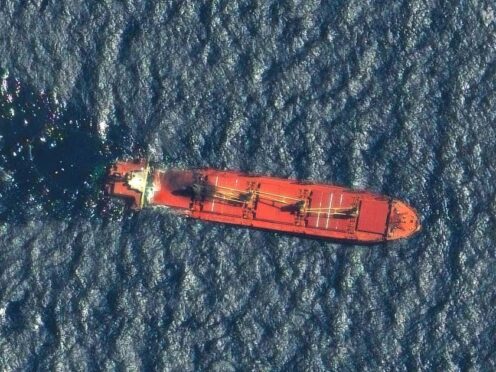
A ship attacked by Yemen’s Houthi rebels has sunk in the Red Sea, becoming the first vessel to be fully destroyed as part of their campaign over Israel’s war against Hamas in Gaza.
The sinking of the Rubymar, which carried a cargo of fertiliser, could cause ecological damage.
Persistent Houthi attacks have already disrupted traffic in the crucial waterway for cargo and energy shipments moving from Asia and the Middle East to Europe. Many ships have turned away from the route.
The sinking could see further detours and higher insurance rates put on vessels plying the waterway — potentially driving up global inflation and affecting aid shipments to the region.

The Belize-flagged Rubymar had been drifting northward after being struck by a Houthi anti-ship ballistic missile on February 18 in the Bab el-Mandeb Strait, a crucial waterway linking the Red Sea and the Gulf of Aden.
Yemen’s internationally recognised government, as well as a regional military official, confirmed the ship sank.
The British military’s United Kingdom Maritime Trade Operations centre, which watches over Middle East waterways, also acknowledged the Rubymar’s sinking on Saturday afternoon.
Yemen’s exiled government, which has been backed by a Saudi-led coalition since 2015, said the Rubymar sank late on Friday as stormy weather took hold over the Red Sea. The vessel had been abandoned for 12 days after the attack, though plans had been made to try and tow the ship to a safe port.
Ahmed Awad Bin Mubarak, the prime minister of Yemen’s internationally recognised government, called the ship’s sinking “an unprecedented environmental disaster”.
“It’s a new disaster for our country and our people,” he wrote on X, formerly Twitter. “Every day, we pay for the Houthi militia’s adventures, which were not stopped at plunging Yemen into the coup disaster and war.”
Greenpeace also raised concerns about the ship sinking.
“Without immediate action, this situation could escalate into a major environmental crisis,” said Julien Jreissati, programme director at Greenpeace MENA.
“As well as any further leaks of fuel oil from the engines, the sinking of the vessel could further breach the hull, allowing water to contact with the thousands of tonnes of fertiliser, which could then be released into the Red Sea and disrupt the balance of the marine ecosystems, triggering cascading effects throughout the food web.”
The Houthis have held Yemen’s capital, Sanaa, since 2014, expelling the government. Its fought a Saudi-led coalition since 2015 in a stalemated war.
Since November, the rebels have repeatedly targeted ships in the Red Sea and surrounding waters over the Israel-Hamas war.
Those vessels have included at least one with cargo bound for Iran, the Houthis’ main benefactor, and an aid ship later bound for Houthi-controlled territory.
Despite over a month of US-led airstrikes, Houthi rebels remain capable of launching significant attacks. That includes the attack on the Rubymar and the downing of an American drone worth tens of millions of dollars.
The Houthis insist their attacks will continue until Israel stops its combat operations in the Gaza Strip, which have enraged the wider Arab world and seen the Houthis gain international recognition.
However, there has been a slowdown in attacks in recent days but the reason for that remains unclear.

Enjoy the convenience of having The Sunday Post delivered as a digital ePaper straight to your smartphone, tablet or computer.
Subscribe for only £5.49 a month and enjoy all the benefits of the printed paper as a digital replica.
Subscribe